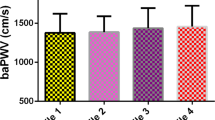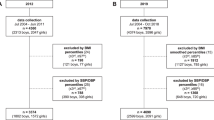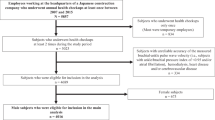Abstract
Brachial-ankle pulse wave velocity (baPWV) has been used as a simple and convenient method of evaluating arterial stiffness and is considered useful for screening subclinical vascular damage in primary care settings and in large populations. The aim of this study was to determine the reference values of baPWV in adolescents based on age and sex to evaluate and classify vascular abnormalities in this age population. Noninvasive baPWV measurements using an oscillometric device were carried out in 5936 participants aged 12–18 years who had no history of syndromic obesity, hypertension, dyslipidemia, diabetes mellitus, or renal disease. Of these, we extracted data from 4524 healthy adolescents free from atherosclerotic risk factors and constructed sex-specific reference percentiles normalized to age using the LMS method. The baPWV increased with age and was significantly higher in males than in females. Multivariate regression analysis demonstrated that age, body mass index, and blood pressure were the major determinants of baPWV for both males and females. Among a sample of 3825 adolescents, including individuals with risk factors, the prevalence of central obesity, raised blood pressure, raised triglycerides, reduced high-density lipoprotein cholesterol, and impaired fasting glycemia significantly increased along with the standardized baPWV z-score level. In addition, there was a graded nature regarding the association between the baPWV z-score and the clustering number of the metabolic syndrome components. These results suggest that the proposed reference values of baPWV could help classify vascular abnormalities of adolescents caused by the presence of risk factors and thereby contribute to determining individuals with cardiovascular risk in this age population.
This is a preview of subscription content, access via your institution
Access options
Subscribe to this journal
Receive 12 print issues and online access
$259.00 per year
only $21.58 per issue
Buy this article
- Purchase on Springer Link
- Instant access to full article PDF
Prices may be subject to local taxes which are calculated during checkout


Similar content being viewed by others
References
Whincup PH, Gilg JA, Donald AE, Katterhorn M, Oliver C, Cook DG, et al. Arterial distensibility in adolescents: the influence of adiposity, the metabolic syndrome, and classic risk factors. Circulation. 2005;112:1789–97.
Miyai N, Arita M, Miyashita K, Morioka I, Takeda S. The influence of obesity and metabolic risk variables on brachial-ankle pulse wave velocity in healthy adolescents. J Hum Hypertens. 2009;23:444–50.
Mikola H, Pahkala K, Niinikoski H, Rönnemaa T, Viikari JSA, Jula A, et al. Cardiometabolic determinants of carotid and aortic distensibility from childhood to early adulthood. Hypertension. 2017;70:452–60.
Bonafini S, Giontella A, Tagetti A, Montagnana M, Benati M, Danese E, et al. Markers of subclinical vascular damages associate with indices of adiposity and blood pressure in obese children. Hypertens Res. 2019;42:400–10.
Raitakari OT, Juonala M, Kähönen M, Taittonen L, Laitinen T, Mäki-Torkko N, et al. Cardiovascular risk factors in childhood and carotid artery intima-media thickness in adulthood: the Cardiovascular Risk in Young Finns Study. J Am Med Assoc. 2003;290:2277–83.
Fernhall B, Agiovlasitis S. Arterial function in youth: window into cardiovascular risk. J Appl Physiol. 1985;2008:325–33.
van Popele NM, Grobbee DE, Bots ML, Asmar R, Topouchian J, Reneman RS, et al. Association between arterial stiffness and atherosclerosis: the Rotterdam Study. Stroke. 2001;32:454–60.
London GM, Marchais SJ, Guerin AP, Pannier B. Arterial stiffness: pathophysiology and clinical impact. Clin Exp Hypertens. 2004;26:689–99.
Laurent S, Katsahian S, Fassot C, Tropeano AI, Gautier I, Laloux B, et al. Aortic stiffness is an independent predictor of fatal stroke in essential hypertension. Stroke. 2003;34:1203–6.
Yamashina A, Tomiyama H, Takeda K, Tsuda H, Arai T, Hirose K, et al. Validity, reproducibility, and clinical significance of noninvasive brachial-ankle pulse wave velocity measurement. Hypertens Res. 2002;25:359–64.
Sugawara J, Hayashi K, Yokoi T, Cortez-Cooper MY, DeVan AE, Anton MA, et al. Brachial-ankle pulse wave velocity: an index of central arterial stiffness? J Hum Hypertens. 2005;19:401–6.
Yamashina A, Tomiyama H, Arai T, Hirose K, Koji Y, Hirayama Y, et al. Brachial-ankle pulse wave velocity as a marker of atherosclerotic vascular damage and cardiovascular risk. Hypertens Res. 2003;26:615–22.
Kohara K, Ochi M, Okada Y, Yamashita T, Ohara M, Kato T, et al. Clinical characteristics of high plasma adiponectin and high plasma leptin as risk factors for arterial stiffness and related end-organ damage. Atherosclerosis. 2014;235:424–9.
Ohnishi H, Saitoh S, Takagi S, Ohata J, Isobe T, Kikuchi Y, et al. Pulse wave velocity as an indicator of atherosclerosis in impaired fasting glucose: the Tanno and Sobetsu study. Diabetes Care. 2003;26:437–40.
Aso K, Miyata M, Kubo T, Hashiguchi H, Fukudome M, Fukushige E, et al. Brachial-ankle pulse wave velocity is useful for evaluation of complications in type 2 diabetic patients. Hypertens Res. 2003;26:807–13.
Munakata M. Brachial-ankle pulse wave velocity in the measurement of arterial stiffness: recent evidence and clinical applications. Curr Hypertens Rev. 2014;10:49–57.
Ohkuma T, Ninomiya T, Tomiyama H, Kario K, Hoshide S, Kita Y, et al. Collaborative Group for J-BAVEL (Japan brachial-ankle pulse wave velocity individual participant data meta-analysis of prospective studies). Brachial-ankle pulse wave velocity and the risk prediction of cardiovascular disease: an individual participant data meta-analysis. Hypertension. 2017;69:1045–52.
Im JA, Lee JW, Shim JY, Lee HR, Lee DC. Association between brachial-ankle pulse wave velocity and cardiovascular risk factors in healthy adolescents. J Pediatr. 2007;150:247–51.
Chu C, Dai Y, Mu J, Yang R, Wang M, Yang J, et al. Associations of risk factors in childhood with arterial stiffness 26 years later: the Hanzhong adolescent hypertension cohort. J Hypertens. 2017;35 Suppl 1:S10–5.
Collins RT, Somes GW, Alpert BS. Differences in arterial compliance among normotensive adolescent groups: collins arterial compliance in adolescents. Pediatr Cardiol. 2008;29:929–34.
Kudo U, Takahashi I, Matsuzaka M, Umeda T, Kitagawa N, Kudo H, et al. Influence of obesity on blood pressure and arterial stiffness in the early teens. Obes Res Clin Pr. 2013;7:e211–7.
Niboshi A, Hamaoka K, Sakata K, Inoue F. Characteristics of brachial-ankle pulse wave velocity in Japanese children. Eur J Pediatr. 2006;165:625–9.
Miyai N, Utsumi M, Gowa Y, Igarashi Y, Miyashita K, Takeda S, et al. Age-specific nomogram of brachial-ankle pulse wave velocity in Japanese adolescents. Clin Exp Hypertens. 2013;35:95–101.
de Onis M, Onyango AW, Borghi E, Siyam A, Nishida C, Siekmann J. Development of a WHO growth reference for school-aged children and adolescents. Bull World Health Organ. 2007;85:660–7.
Cole TJ, Green PJ. Smoothing referee centile curves: the LMS method and penalized likelihood. Stat Med. 1992;11:1305–19.
Tomiyama H, Yamashina A, Arai T, Hirose K, Koji Y, Chikamori T, et al. Influences of age and gender on results of noninvasive brachial-ankle pulse wave velocity measurement-a survey of 12517 subjects. Atherosclerosis. 2003;166:303–9.
Blacher J, Asmar R, Djane S, London GM, Safar ME. Aortic pulse wave velocity as a marker of cardiovascular risk in hypertensive patients. Hypertension. 1999;33:1111–7.
Mancia G, De Backer G, Dominiczak A, Cifkova R, Fagard R, Germano G, et al. ESH-ESC task force on the management of arterial hypertension. 2007 ESH-ESC practice guidelines for the management of arterial hypertension: ESH-ESC task force on the management of arterial hypertension. J Hypertens. 2007;25:1751–62.
Tanaka H, Munakata M, Kawano Y, Ohishi M, Shoji T, Sugawara J, et al. Comparison between carotid-femoral and brachial-ankle pulse wave velocity as measures of arterial stiffness. J Hypertens. 2009;27:2022–7.
Townsend RR, Wilkinson IB, Schiffrin EL, Avolio AP, Chirinos JA, Cockcroft JR. American Heart Association Council on Hypertension et al. Recommendations for improving and standardizing vascular research on arterial stiffness: a scientific statement from the American heart association. Hypertension. 2015;66:698–722.
Jurko T, Mestanik M, Jurko A Jr, Spronck B, Avolio A, Mestanikova A, et al. Pediatric reference values for arterial stiffness parameters cardio-ankle vascular index and CAVI0. J Am Soc Hypertens. 2018;12:e35–e43.
Senzaki H, Akagi M, Hishi T, Ishizawa A, Yanagisawa M, Masutani S, et al. Age-associated changes in arterial elastic properties in children. Eur J Pediatr. 2002;161:547–51.
Sarkola T, Manlhiot C, Slorach C, Bradley TJ, Hui W, Mertens L, et al. Evolution of the arterial structure and function from infancy to adolescence is related to anthropometric and blood pressure changes. Arterioscler Thromb Vasc Biol. 2012;32:2516–24.
Elmenhorst J, Hulpke-Wette M, Barta C, Dalla Pozza R, Springer S, Oberhoffer R. Percentiles for central blood pressure and pulse wave velocity in children and adolescents recorded with an oscillometric device. Atherosclerosis. 2015;238:9–16.
Rossi P, Francès Y, Kingwell BA, Ahimastos AA. Gender differences in artery wall biomechanical properties throughout life. J Hypertens. 2011;29:1023–33.
McCrohon JA, Nakhla S, Jessup W, Stanley KK, Celermajer DS. Estrogen and progesterone reduce lipid accumulation in human monocyte-derived macrophages: a sex-specific effect. Circulation. 1999;100:2319–25.
Meyer MR, Clegg DJ, Prossnitz ER, Barton M. Obesity, insulin resistance and diabetes: sex differences and role of estrogen receptors. Acta Physiol. 2011;203:259–69.
Thurn D, Doyon A, Sözeri B, Bayazit AK, Canpolat N, Duzova A, et al. Aortic pulse wave velocity in healthy children and adolescents: reference values for the Vicorder device and modifying factors. Am J Hypertens. 2015;28:1480–8.
Kosger P, Ozdemir G, Yildirim A, Ucar B, Kilic Z. Early myocardial changes in normotensive children of hypertensive parents: a tissue Doppler study. Hypertens Res. 2018;41:897–903.
Funding
This work was supported by JSPS KAKENHI grant numbers JP 16390183 and JP 20500618 and by a 2014 joint research grant from the Faculty of Health and Nursing Science, Wakayama Medical University.
Author information
Authors and Affiliations
Corresponding author
Ethics declarations
Conflict of interest
The authors declare that they have no conflicts of interest.
Additional information
Publisher’s note Springer Nature remains neutral with regard to jurisdictional claims in published maps and institutional affiliations.
Rights and permissions
About this article
Cite this article
Sougawa, Y., Miyai, N., Utsumi, M. et al. Brachial-ankle pulse wave velocity in healthy Japanese adolescents: reference values for the assessment of arterial stiffness and cardiovascular risk profiles. Hypertens Res 43, 331–341 (2020). https://doi.org/10.1038/s41440-019-0370-z
Received:
Revised:
Accepted:
Published:
Issue Date:
DOI: https://doi.org/10.1038/s41440-019-0370-z
Keywords
This article is cited by
-
Association between brachial-ankle pulse wave velocity and microvascular complications in type 2 diabetes mellitus
BMC Endocrine Disorders (2023)
-
Atherosclerosis and arteriosclerosis
Hypertension Research (2023)
-
Microvascular reactivity using laser Doppler measurement in type 2 diabetes with subclinical atherosclerosis
Lasers in Medical Science (2023)
-
Dendritic cells as potential initiators of immune-mediated hypertensive disorders
Hypertension Research (2022)
-
Reference values of office central blood pressure, pulse wave velocity, and augmentation index recorded by means of the Mobil‐O‐Graph PWA monitor
Hypertension Research (2020)



